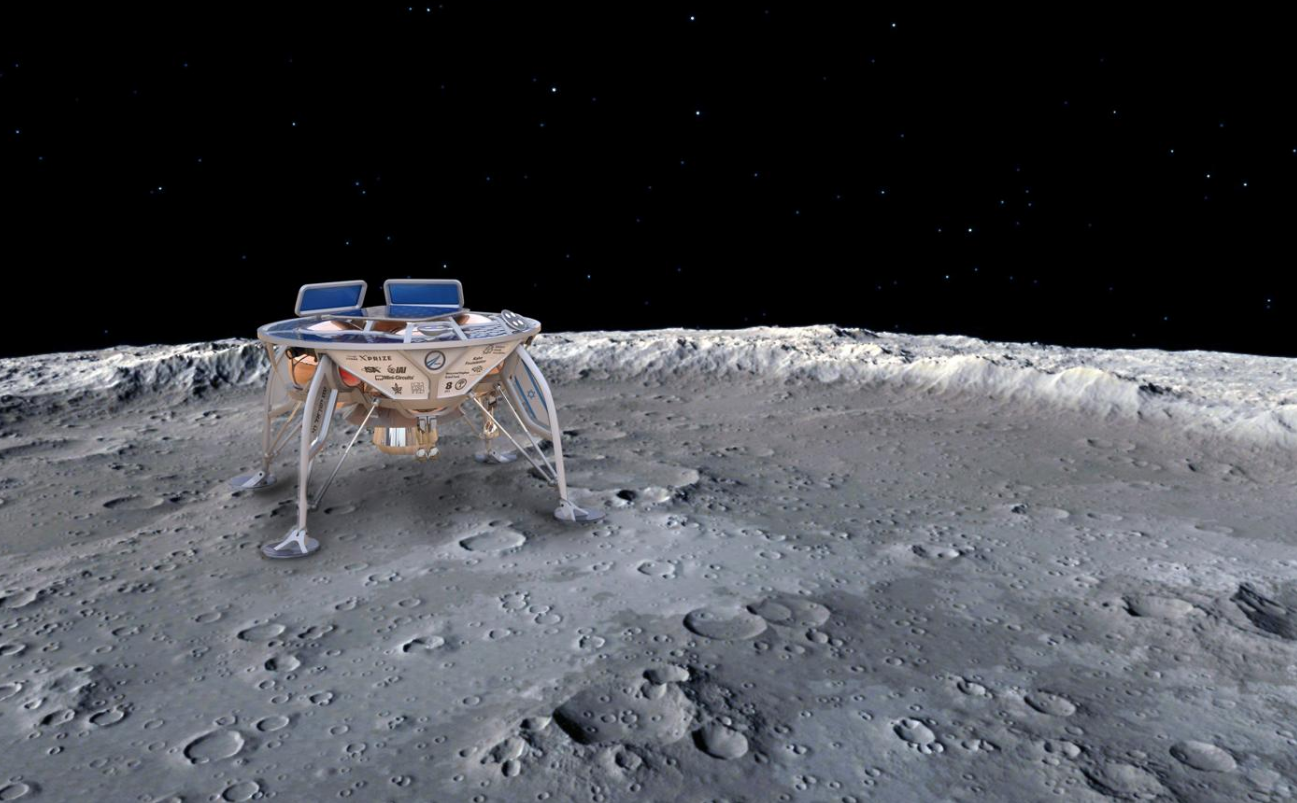SpaceIL is an Israeli nonprofit organization, established in 2011, that was competing in the Google Lunar X Prize (GLXP) to land a spacecraft on the Moon. The contest declared no winner, but SpaceIL still aims to launch the spacecraft in 2019. SpaceIL team was formed as a nonprofit organization wishing to promote scientific and technological education in Israel. Its total budget is estimated at US$70 million, provided mainly by philanthropists and the Israel Space Agency (ISA).
- technological education
- glxp
- spaceil
1. History

SpaceIL began as part of the Google Lunar X Prize, which offered $30m (£23m) in prizes to inspire people to develop low-cost methods of robotic space exploration. The entry was unique among GLXP contenders, in that instead of building a tracked or wheeled rover, SpaceIL planned to meet the requirement to travel 500 meters on the lunar surface by having the lander "hop" from its landing site to another site 500 meters away using rocket propulsion.[1][2]
In April 2014, American philanthropist Sheldon Adelson donated US$16.4 million to the project,[3] and in June 2017, the Israeli Space Agency (ISA) announced a donation of additional 7.5 million NIS, after having donated 2 million NIS in previous years.[4]
In August 2017, Google Lunar Xprizes announced an extension of the deadline to 31 March 2018.[5][6] The contest ended without a winner,[7] but SpaceIL still plans on launching the mission.
In November 2017, SpaceIL announced they need $30M to finish the project. Morris Kahn resigned from chairing the board, and promised $10M if the organization can raise the additional $20M.[8] The current CEO is Ido Anteby, and the President of SpaceIL remains Morris Kahn.[9] As of July 2018, the project has cost approximately $95 million.[9]
1.1. Founders and Supporters
The founders of the team are: Yariv Bash, former electronics and computer engineer in the Interdisciplinary Center in Herzliya, and currently Flytrex CEO; Kfir Damari, a Computer Networking lecturer; and Yonatan Winetraub, formerly a satellite systems engineer at Israel Aerospace Industries, and currently a biophysics PhD Candidate at Stanford. Morris Kahn is the President the board [10] and donor of $27 million to the project.[9]
The team has technical support from the Israel Space Agency (ISA), Israel Aerospace Industries, Rafael Systems and Elbit Systems. SpaceIL is also supported by educational institutions, including the Technion, Tel Aviv University, Weizmann Institute of Science and Ben-Gurion University of the Negev.[11] SpaceIL has over 200 members, 95% of them are volunteers. By 2017, SpaceIL volunteers reached over 250,000 pupils all around Israel.
The founders of the team stated that if they had won the competition, the money would have been donated to educational purposes.[11]
2. Launch
In October 2015, SpaceIL signed a contract for a launch from Cape Canaveral in Florida on a SpaceX Falcon 9 via Spaceflight Industries.[9][12] It will be launched as a secondary payload on a Falcon 9, whose primary payload is a commercial communications satellite.[13] The 585-kilogram lander is informally called Sparrow.[14] Once Sparrow is in Earth orbit and separated from the Falcon 9 launcher, and after several orbits around Earth, the spacecraft will slowly perform orbit raising. The orbit raising would take 2.5 month before reaching the Moon's area of influence. Once there, the spacecraft will perform manuevers to be captured in a Lunar orbit, and orbit around the Moon between two weeks and 1 month. In the right orbit around the landing site, it will decelerate until soft-landing on the lunar surface.[15]
3. Status
By June 2017, the lander spacecraft was undergoing integration and testing.[4][9] Launch is scheduled for 2019.[16][17]
4. Sparrow Lander
- Dimensions: about 2 m (6.6 ft) in diameter and 1.5 m high.[18]
- Mass: 585 kg (1,300 lb) at launch; approximately 400 kg of that mass is propellant.[18]
- Science payload: magnetometer by the Weizmann Institute of Science
- Operation time: 2 days[9]
The content is sourced from: https://handwiki.org/wiki/Engineering:SpaceIL
References
- "Israel slated to be 4th country to land vehicle on the moon – Israel Hayom" (in en-US). http://www.israelhayom.com/2017/01/25/israel-slated-to-be-4th-country-to-land-vehicle-on-the-moon/.
- "Israeli XPrize Mission Science Twist: Map Lunar Magnetism (Op-Ed)". http://www.space.com/27704-israeli-lunar-xprize-craft-to-study-magnetism.html.
- "Israel space project gets $16 million boost from casino mogul Adelson". Reuters. 9 April 2014. https://www.reuters.com/article/2014/04/09/us-israel-space-adelson-idUKBREA381FH20140409. Retrieved 9 April 2014.
- "On the way to the Moon: the Ministry of science will increase the investment in SpaceIL (in Hebrew)". Ynet. June 29, 2017. http://www.ynet.co.il/articles/0,7340,L-4982597,00.html.
- "Guidelines" (in en). Google Lunar XPRIZE. 2015-10-07. https://lunar.xprize.org/about/guidelines.
- "Google-sponsored private moon race delayed for the fourth time" (in en-US). New Scientist. https://www.newscientist.com/article/2144314-google-sponsored-private-moon-race-delayed-for-the-fourth-time/?campaign_id=RSS%7CNSNS-news.
- "Ex-Prize: Google's $30 Million Moon Race Ends with No Winner". https://www.space.com/39467-google-lunar-xprize-moon-race-ends.html.
- Yaron Drokman (November 23, 2017). "SpaceIL: If we don't raise enough money by January 2018, we will have to close the project (in Hebrew)". Ynet. http://www.ynet.co.il/articles/0,7340,L-5047017,00.html.
- Winner, Stewart; Solomon, Shoshanna (10 July 2018). "Israeli spacecraft aims for historic moon landing… within months". The Times of Israel. https://www.timesofisrael.com/in-first-israeli-spacecraft-set-for-trip-to-the-moon/.
- "To the moon and back". The Jerusalem Post | JPost.com. http://www.jpost.com/Israel-News/To-the-moon-and-back-462707.
- SpaceIL still aims to launch עתידות: עד 2017 תנחת חללית ישראלית על הירח (By 2017, an Israeli spacecraft will land on the moon.) Haaretz, October 7, 2015 http://www.haaretz.co.il/news/science/.premium-1.2746550
- Google Lunar XPrize, 7 Oct 2015 http://lunar.xprize.org/press-release/israeli-google-lunar-xprize-team-first-sign-launch-agreement-private-mission
- SpaceIL making final fundraising push for lunar lander mission. Jeff Foust, SpaceNews. 14 December 2017. http://spacenews.com/spaceil-making-final-fundraising-push-for-lunar-lander-mission/
- An Israeli Moonshot. Lee Billings, Scientific American. 17 March2016. https://www.scientificamerican.com/article/an-israeli-moonshot-q-a/
- "Recalculating Route: The plan of spacecraft’s trajectory has been completed". SpaceIL. July 2018. http://www.spaceil.com/general/%D7%9E%D7%97%D7%A9%D7%91%D7%AA-%D7%9E%D7%A1%D7%9C%D7%95%D7%9C-%D7%9E%D7%97%D7%93%D7%A9-%D7%94%D7%95%D7%A9%D7%9C%D7%9E%D7%94-%D7%AA%D7%9B%D7%A0%D7%99%D7%AA-%D7%91%D7%A0%D7%99%D7%99%D7%AA-%D7%94%D7%9E/.
- SpaceX Falcon 9 rideshare launch to send a commercial lander to the Moon in 2019. Eric Ralph, Teslarati. 12 September 2018. https://www.teslarati.com/spacex-falcon-9-rideshare-commercial-lunar-lander-2019/
- Ronel, Asaf (10 July 2018). "First Israeli Spacecraft to Head to Moon on Back of Elon Musk's SpaceX Rocket". Haaretz. https://www.haaretz.com/israel-news/.premium-first-israeli-spacecraft-to-the-moon-to-launch-in-december-1.6264356.
- Israeli unmanned spacecraft to land on Moon in 2019. BBC News. July 2018. https://www.bbc.com/news/world-middle-east-44777305
